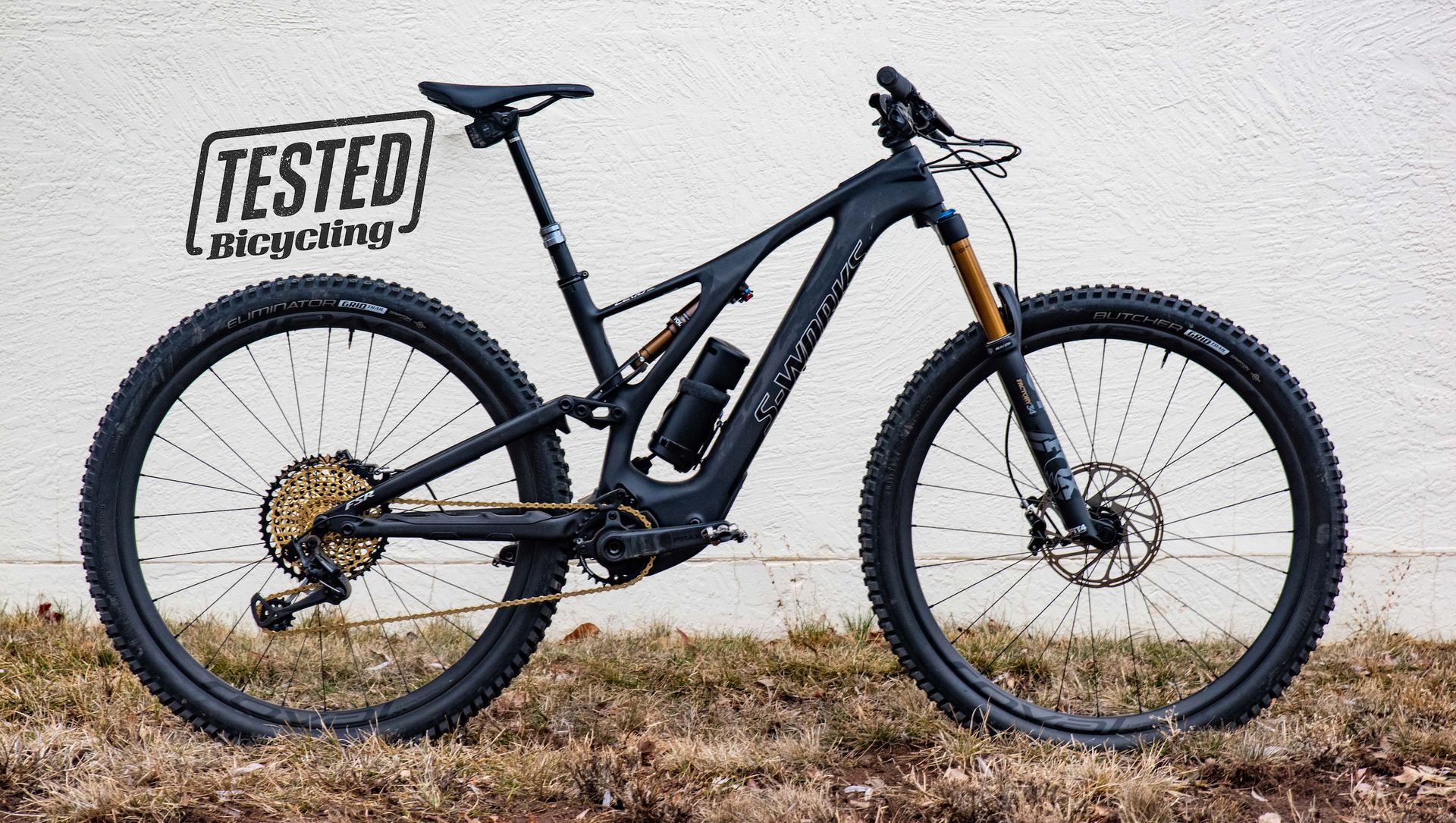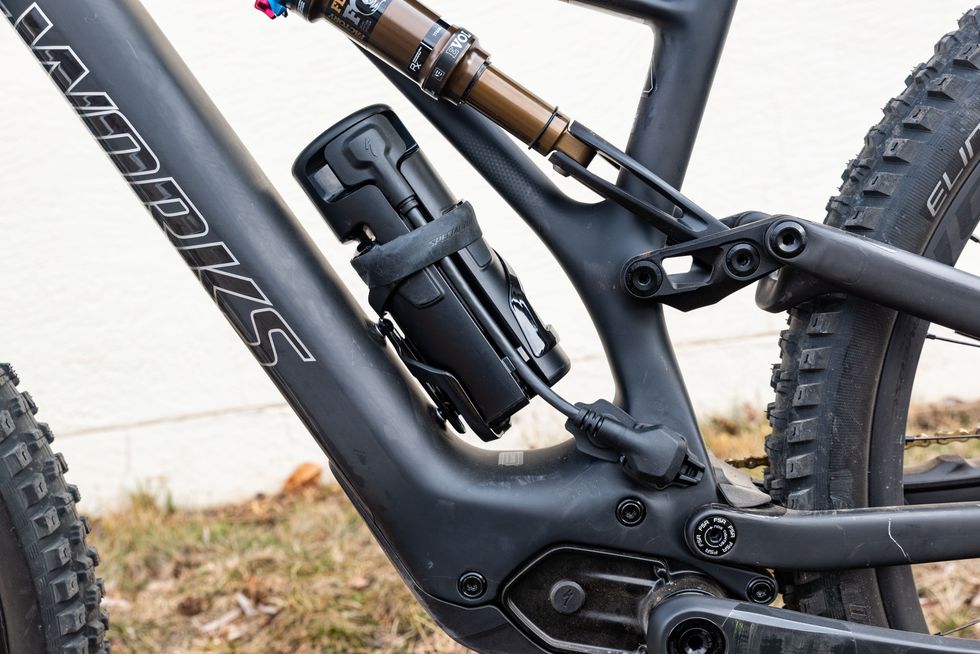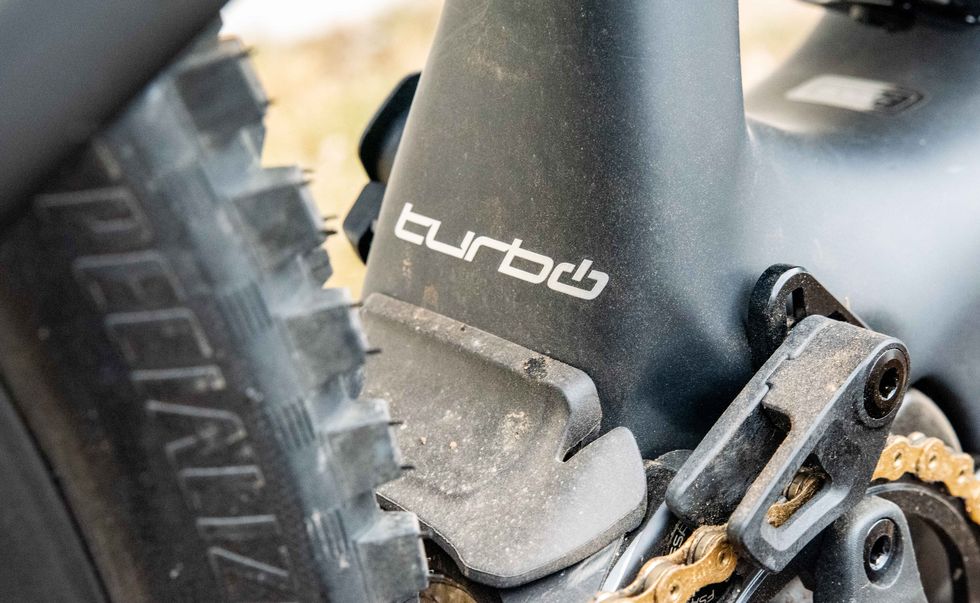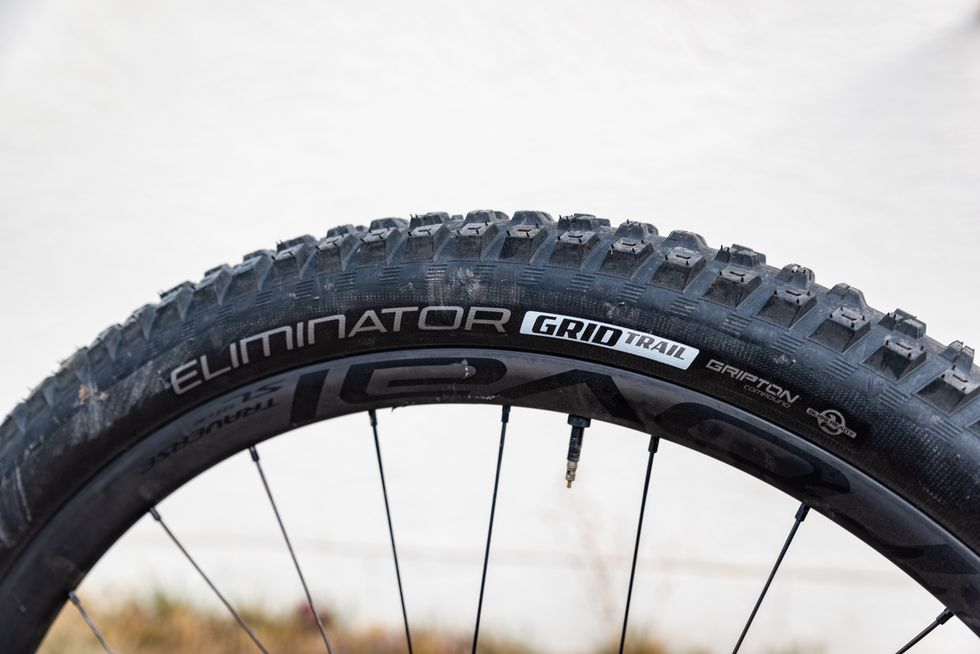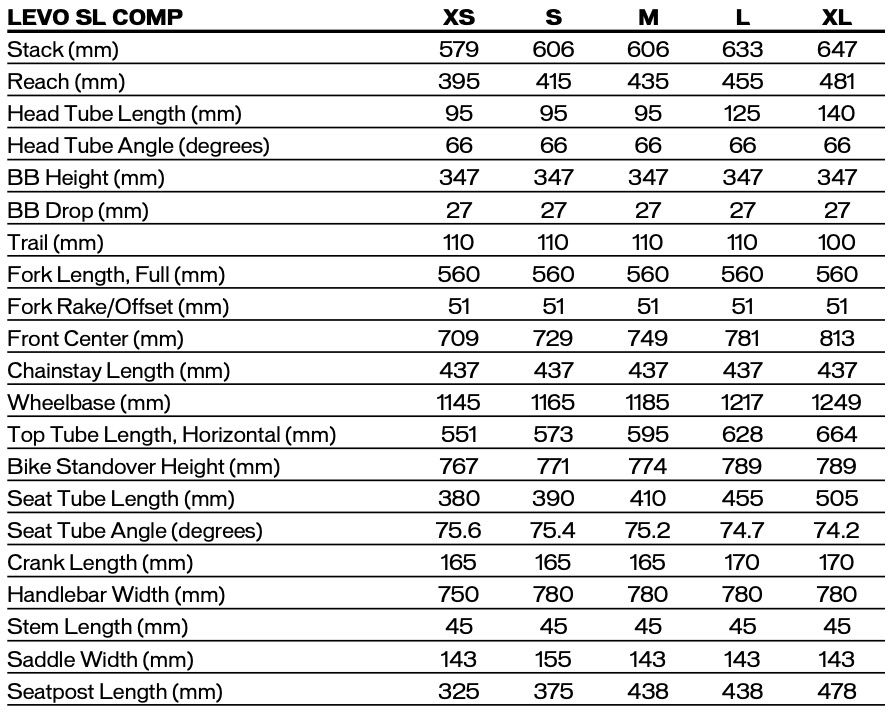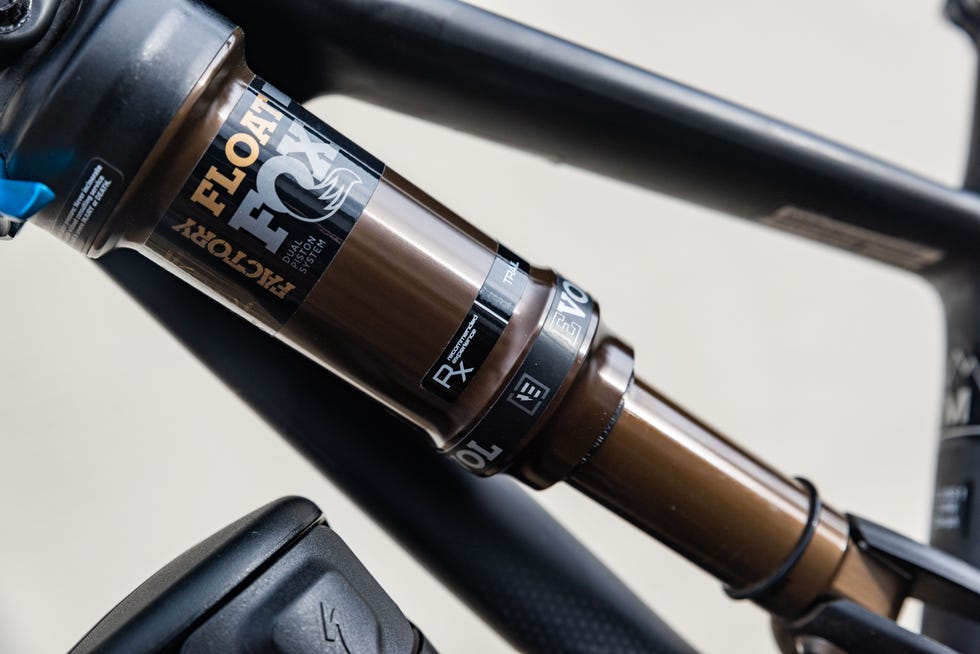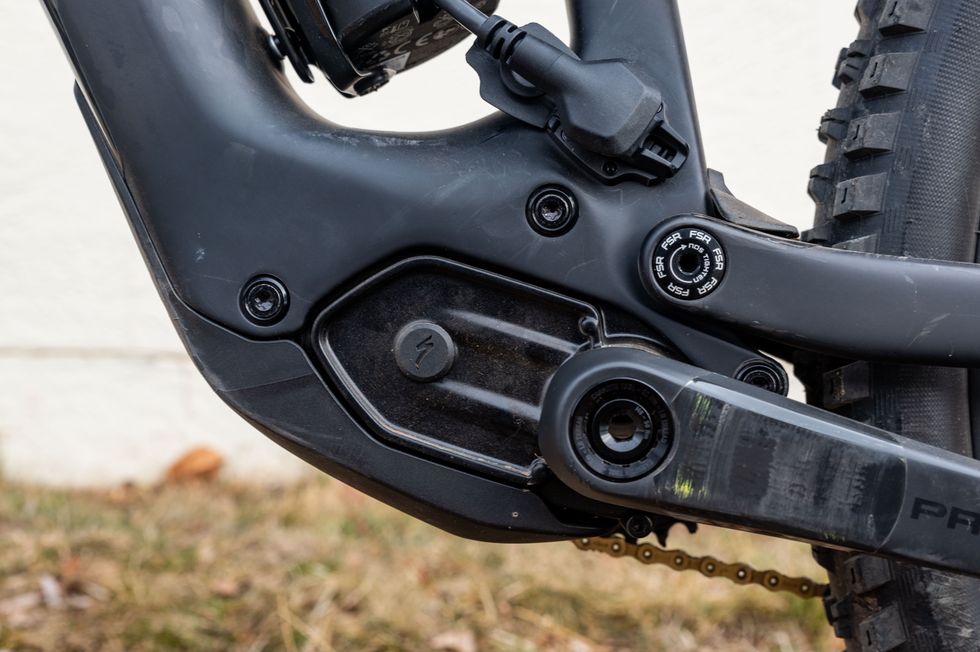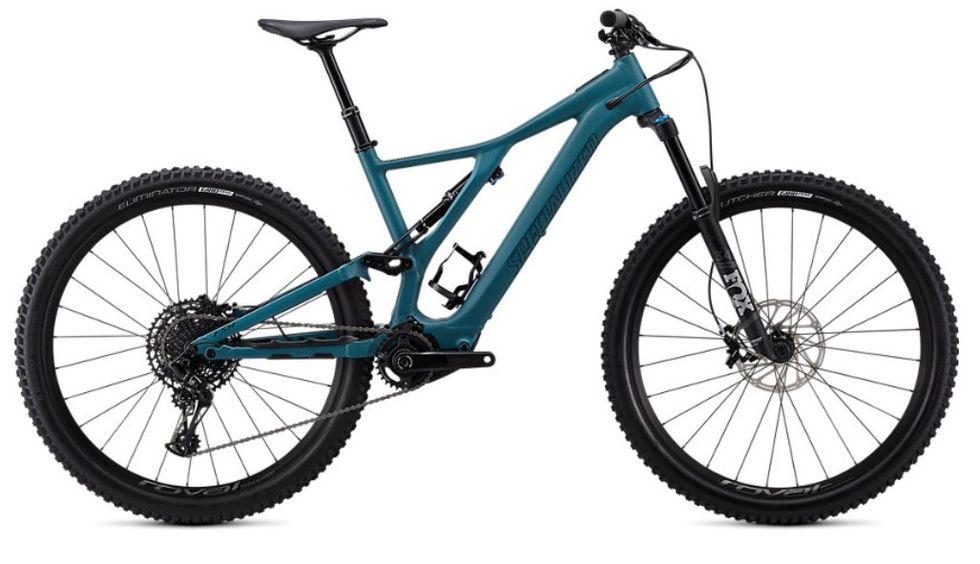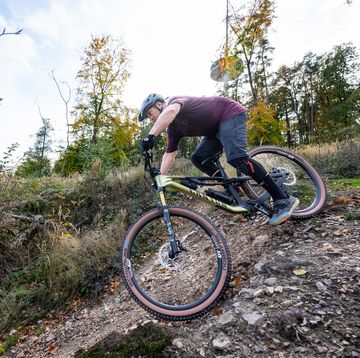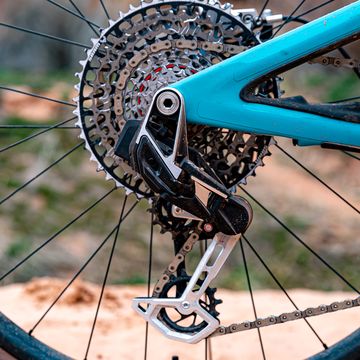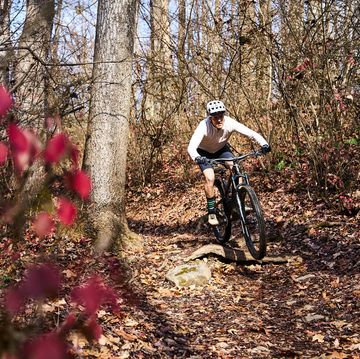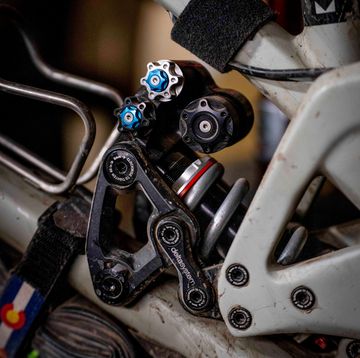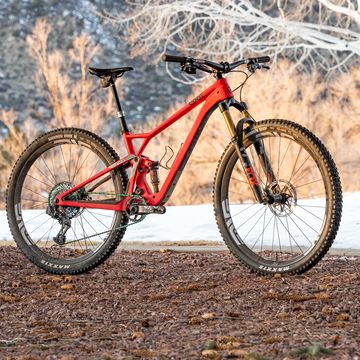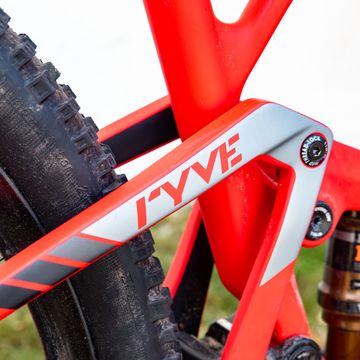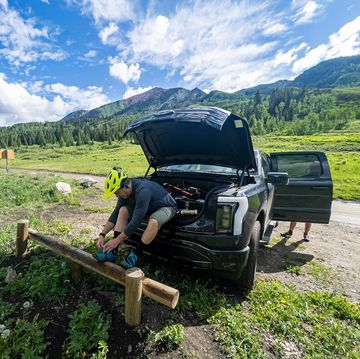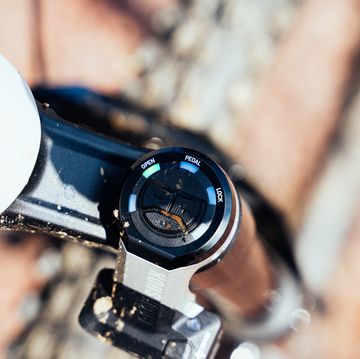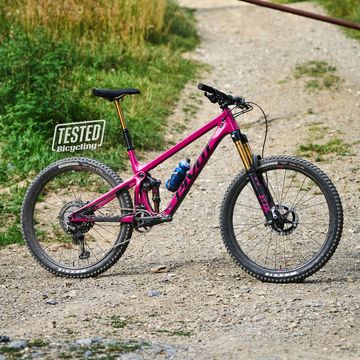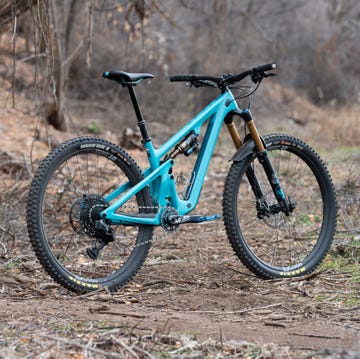The Takeaway: The Levo SL is a less powerful, lighter, and more graceful e-mountain bike.
• 29er trail bike
• 150 mm travel front and rear
• S-Works model just 36.5 pounds
• Same motor and battery as Creo SL
Price: $13,525 (S-Works)
Weight: 36.5 lb. (medium)
Specialized’s new Levo SL e-mountain bike—available in shops now—uses the formula used to create the brand’s game-changing Creo SL e-road bike. While the usual recipe for a new e-bike is more power and a bigger battery, Specialized took the Colin Chapman—founder of Lotus Cars—approach: “Simplify, then add lightness.”
Instead of more, Specialized uses less on the Levo SL, its new 150mm-travel 29er e-bike that is based on the Stumpjumper. A lighter, smaller, and less powerful motor requires a smaller and lighter battery. It’s this formula that helps the SL bikes achieve their shocking, for a mid-motor e-bike, weights.
On my scale, the medium S-Works Levo SL weighs 36.5 pounds—that’s 10 pounds lighter than the Turbo Levo Expert we reviewed last year. According to Specialized, the S-Works Levo SL is 8.8 pounds lighter than the S-Works Turbo Levo. Considering the weights of today’s acoustic 150mm 29er trail bikes—even high-end ones can weigh close to 30 pounds—the Levo SL’s weight is quite stunning.
The SL 1.1 motor used in the Levo SL is the same motor found in the Creo SL, though with a few adjustments—like walk-assist—for mountain-bike duty. The SL motor weighs 1,950 grams—that’s 1,100 grams less than the 2.1 motors in the brand’s Levo and Kenevo models. It’s also much smaller and takes up less space in the frame.
But it’s also less powerful—the SL 1.1 motor kicks out a maximum of 35Nm of torque and 240 watts of assist while the 2.1 motor can put out 90Nm of torque and offers 560 watts peak assist. The battery is less powerful too: SL’s in-frame battery is rated to 320Wh while the battery in the high-end Levo models is rated to 700Wh. However, the SL is compatible with a 160Wh range extender battery (it weighs about 1,000 grams), which slides into the bottle cage.
Specialized claims the Levo SL will run for three hours with its internal battery in the lowest assist mode; with the range extender, run time jumps to five hours. For comparison, the S-Works Turbo Levo with its 700Wh internal battery has a claimed run time of five hours.
The Levo SL comes from the factory with four riding modes that match the rider’s power up to the modes’ maximum assist. Eco provides up to 72 watts of support, Trail offers up to 144 watts of support, and Turbo offers up to 240 watts of support.
The fourth mode is “off.” Specialized says the motor decouples when not providing assistance and claims it offers no more drag than a conventional bottom bracket.
The Levo SL shares the same simple controls found on the Turbo Levo and Kenevo. The power button/mode switch and fuel gauge are located in a small panel in the top tube. There’s also a small handlebar remote that switches modes and activates walk mode. These clean and straightforward controls paired with the (comparatively) tiny motor and normal-looking downtube make this the stealthiest mid-motor e-bike around. The control panel and battery gauge and be turned off for more stealth.
Specialized’s powerful smartphone app, Mission Control, offers more in-depth information and settings. Through it, the rider can see stats, update firmware, and customize the assist modes. The app provides an additional mode called Smart Control, which lets the rider set a ride time or distance—and a comfortable battery reserve—then monitors battery life and adjusts motor output to reach the user’s targets. The Levo SL also pairs to some GPS head units via ANT+.
Ride Impressions
At $13,525, this is the most expensive mountain bike I’ve ever tested. It’s based on the brand’s 150mm Stumpjumper 29er. Though I like many things about this platform, I find it a bit too short—size medium has 435mm reach, I prefer 450 to 460mm. That said, this bike has well-balanced handling (better slow-speed manners than many trail bikes), excellent suspension, and an impressive build.
The Levo SL rides more like an unpowered mountain bike than any e-bike I’ve yet ridden. On other e-mountain bike’s I’ve tested, the motor is so powerful and so front-of-mind that it provides a trail experience all its own—it doesn’t feel like mountain biking but doesn’t not feel like mountain biking. The way I pick trails to ride and pick lines on those trails is different on a typical e-mountain bike that it is on an acoustic mountain bike. The weight and power of a conventional e-mountain bike feels, to me, more suited and more fun to ride on higher speed and more open trails.
But where the typical e-mountain bike is a machete, the Levo SL is a scalpel. It’s a light and precise instrument that is easy to finesse through tight terrain. There’s still plenty of power, but the power is delivered so smoothly and subtly, and the Levo SL is so (comparatively) light, that it’s a less brutal and blunt-force e-bike experience and more like a typical mountain bike experience.
Higher-power e-mountain bikes push you along and seem designed to knock out climbs as quickly and efficiently as possible—tools for self-shuttling downhill runs. The Levo SL doesn’t feel like a chairlift—it makes (some) rides a little bit faster and the climbs a little bit easier without losing its bike-ness. It’s a lively and toss-able trail bike and feels more you than it.
Frankly, I don’t know what to make of the Levo SL. Why pick lighter e-bike with less power over a heavier e-bike with more power? Isn’t “more” the whole point of an e-bike? Will e-bike shoppers willingly give up power for a more traditional mountain bike experience? If a rider is looking for a more traditional mountain bike experience, would they not just get a (cheaper and lighter) un-powered mountain bike? Specialized is about to find out.
The Levo SL occupies the space between powerful e-bikes like Specialized’s Turbo Levo and an unpowered mountain bike—a space that was empty until it came along. I found it a more pleasant e-bike experience than what I got from other e-mountain bikes I’ve ridden because the ‘e’ part of it doesn’t take over the ride.
It’s less clunky, less numb, less brutal than the typical e-bike, and more like an acoustic mountain bike; it provides nearly the experience of riding an unpowered mountain bike with a subtle boost to let you ride further, faster, more easily. I’m not sure the typical e-bike customer is ready for this Colin Chapman approach, but the Levo SL is the most unique and exciting e-mountain bike on the market right now.
Levo SL Models
The Levo SL launches with five models: The Founder’s Edition ($16,525), S-Works ($13,525), Expert ($9,025), Comp Carbon ($7,525), and Comp ($6,525). All models use the same software, motor, and internal battery—the two most expensive models come with a range extender; pick up one of the less-expensive models, and the extender will cost $450.
The least expensive model uses an aluminum frame while all other models use the same full-carbon frame. The aluminum Levo SL Comp comes in five sizes—extra small through extra-large—while carbon models come in small through extra-large.
All models use SRAM Eagle drivetrains and are equipped with size-specific dropper posts and tubeless-ready wheels and tires. A Specialized water bottle cage and SWAT tool—tucked into the fork’s steerer—are stock on every model.

A gear editor for his entire career, Matt’s journey to becoming a leading cycling tech journalist started in 1995, and he’s been at it ever since; likely riding more cycling equipment than anyone on the planet along the way. Previous to his time with Bicycling, Matt worked in bike shops as a service manager, mechanic, and sales person. Based in Durango, Colorado, he enjoys riding and testing any and all kinds of bikes, so you’re just as likely to see him on a road bike dressed in Lycra at a Tuesday night worlds ride as you are to find him dressed in a full face helmet and pads riding a bike park on an enduro bike. He doesn’t race often, but he’s game for anything; having entered road races, criteriums, trials competitions, dual slalom, downhill races, enduros, stage races, short track, time trials, and gran fondos. Next up on his to-do list: a multi day bikepacking trip, and an e-bike race.
